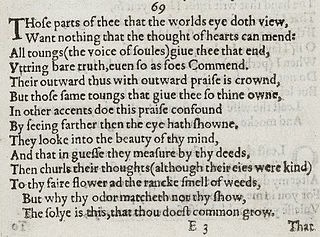
This article presents a possible chronological listing of the composition of the plays of William Shakespeare.
Sonnet 5 is one of 154 sonnets written by the English playwright and poet William Shakespeare. It is a procreation sonnet within the Fair Youth sequence. Sonnet 5 is linked to Sonnet 6, which continues the theme of distillation.

Sonnet 23 is one of a sequence of 154 sonnets written by the English playwright and poet William Shakespeare, and is a part of the Fair Youth sequence.
Sonnet 24 is one of 154 sonnets written by the English playwright and poet William Shakespeare, and is a part of the Fair Youth sequence.

Sonnet 27 is one of 154 sonnets published by William Shakespeare in a quarto titled Shakespeare's Sonnets in 1609. It is a part of the Fair Youth group of sonnets, and the first in a group of five sonnets that portray the poet in solitude and meditating from a distance on the young man. A theme of the first two of the group regards the night and restlessness, which is a motif also found in the sonnets of Petrarch.

Sonnet 31 is one of 154 sonnets written by the English playwright and poet William Shakespeare. It is a sonnet within the Fair Youth sequence. Developing an idea introduced at the end of Sonnet 30, this poem figures the young man's superiority in terms of the possession of all the love the speaker has ever experienced.

Shakespeare's Sonnet 34 is included in what is referred to as the Fair Youth sequence, and it is the second of a briefer sequence concerned with a betrayal of the poet committed by the young man, who is addressed as a personification of the sun.

Sonnet 38 is one of 154 sonnets written by the English playwright and poet William Shakespeare. It is a member of the Fair Youth sequence, in which the lyric subject expresses its love towards a young man.

Sonnet 48 is one of 154 sonnets written by the English playwright and poet William Shakespeare. It is a member of the Fair Youth sequence, in which the poet expresses his love towards a young man.

Sonnet 49 is one of 154 sonnets written by the English playwright and poet William Shakespeare. It is a member of the Fair Youth sequence, in which the poet expresses his love towards a young man.

Sonnet 54 is one of 154 sonnets published in 1609 by the English playwright and poet William Shakespeare. It is considered one of the Fair Youth sequence. This sonnet is a continuation of the theme of inner substance versus outward show by noting the distinction between roses and canker blooms; only roses can preserve their inner essence by being distilled into perfume. The young man's essence or substance can be preserved by verse.

A bad quarto, in Shakespearean scholarship, is a quarto-sized printed edition of one of Shakespeare's plays that is considered to be unauthorised, and is theorised to have been pirated from a theatrical performance without permission by someone in the audience writing it down as it was spoken or, alternatively, written down later from memory by an actor or group of actors in the cast – the latter process has been termed "memorial reconstruction". Since the quarto derives from a performance, hence lacks a direct link to the author's original manuscript, the text would be expected to be "bad", i.e. to contain corruptions, abridgements and paraphrasings.

Sonnet 67 is one of 154 sonnets written by the English playwright and poet William Shakespeare. It's a member of the Fair Youth sequence, in which the poet expresses his love towards a young man, and is a thematic continuation of Sonnet 66. In this poem, the speaker's anxiety about the social difference between him and his beloved takes the form of a criticism of courtly corruption. This sonnet was placed first in the pirated and mangled edition of 1640.

Shakespeare's Sonnet 69, like many of those nearby in the sequence, expresses extremes of feelings about the beloved subject, who is presented as at once superlative in every way and treacherous or disloyal.

Sonnet 81 is one of 154 sonnets written by William Shakespeare, and published in a quarto titled Shakespeare's Sonnets in 1609. It is a part of the Fair Youth series of sonnets, and the fourth sonnet of the Rival Poet series.

Sonnet 82 is one of 154 sonnets published by William Shakespeare in a quarto titled Shakespeare's Sonnets in 1609. It is a part of the Fair Youth series of sonnets, and the fifth sonnet of the Rival Poet group.

Sonnet 83 is one of 154 sonnets published by William Shakespeare in a quarto titled Shakespeare's Sonnets in 1609. It is a part of the Fair Youth group of sonnets, and the sixth sonnet of the Rival Poet group.
Sonnet 113 is one of 154 sonnets written by the English playwright and poet William Shakespeare. It's a member of the Fair Youth sequence, in which the poet expresses his love towards a young man.
Teena Rochfort-Smith was a Victorian Shakespearean scholar and philologist most notable for her contributions to the form of the scholarly edition.

Harold Jenkins, FBA is described as "one of the foremost Shakespeare scholars of his century".















